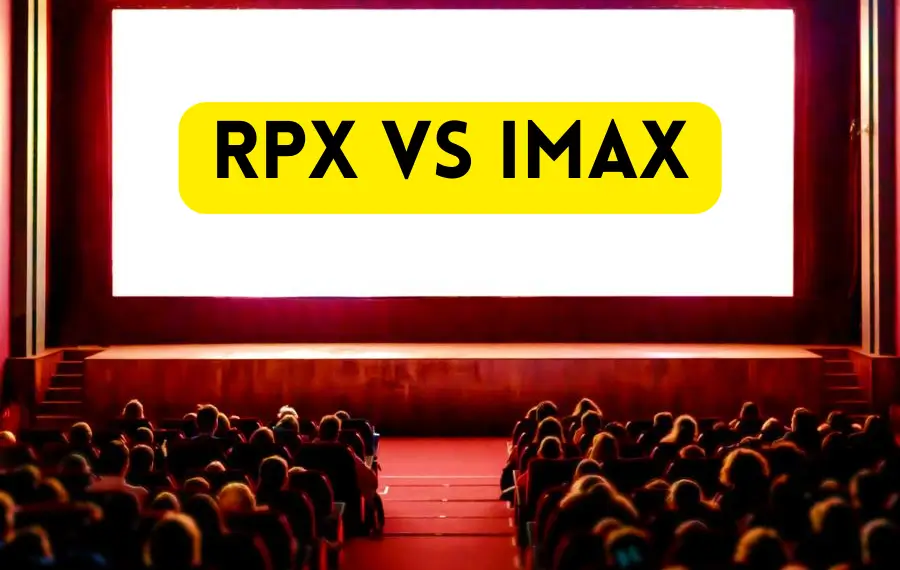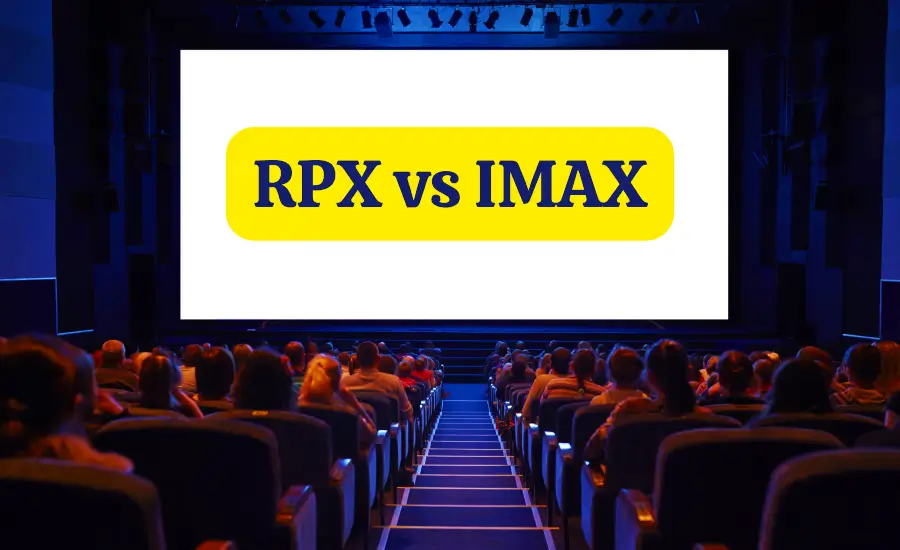Both RPX and IMAX are newer, high-definition film formats that are gaining in popularity. In order to really appreciate a film, you must have a good understanding of both RPX and IMAX.
Because a moviegoer’s ability to choose a suitable venue is critical, the quality of the theater has a significant impact on your enjoyment of the film.
RPX screens are usually 40 feet by 60 feet. IMAX screens are typically 52×70 feet. Of course, some are larger than that. No matter which of these viewing formats you go with, you’re getting a much larger screen than your traditional movie experience.
This article will cover both of these types of movie formats. We’ll thoroughly compare the two, looking at their similarities and differences. That being said, be sure to see it through to the very finish.
Difference Between RPX and IMAX
| Comparison Parameters | RPX | IMAX |
|---|---|---|
| Comfortability | Highly comfortable and leathery seats have higher back, headrests, and are recliners. | Seats are better than Standard theaters but not comfortable like RPX. |
| Infrastructure and Technology | It uses a flat-screen. RPX also has Digital projection technology. Its screen is wider than IMAX. | Curved screens stretching across the walls, 2K laser projectors. |
| Screen Display | The screen is 40 feet tall and 60 feet wide. As compared to IMAX, the screen is wider but shorter in length. | The screen is 70-100 feet tall and 53 feet wide. |
| Sound System | A 7.1 channel surround sound system plus low-frequency transducers are installed in each seat. | A 12 channel surround sound system with enhanced clarity. |
| Movie Experience | RPX also gives a 3D movie effect. It is suitable to watch 3D movies. | 3D movies with immersive effects, the viewer feels himself a part of the scene. |
| Cost | It costs $5 more than traditional screens. But, every penny proves it worth it. | It costs $5 extra than IMAX. |
| Which is Better? | Every sort of movie can be watched in RPX cinema. It provides RealD 3D, 2D as well as other movie formats. | IMAX is not suitable for certain movies such as romance and story-oriented. Because dialogues are more important than scenery in such movies. |
RPX vs IMAX: Introduction
A cinema technology known as IMAX stands for “Image Maximum.” Huge screen displays and 3D format are prominent features.
Larger cameras, digital dual laser projectors, and a superb sound system combine to provide an immersive cinematic experience.
The abbreviation “Regal Premium Experience” (RPX) stands for the full phrase. It’s also technology in the cinema that’s ahead of what IMAX can do. This is Regal Cinema’s newest and largest screen, the RPX.
It also has a large screen and a top-notch audio system. However, it offers several advantages over IMAX in terms of functionality.
Digital projectors of greater size and superior quality are used. So, the display is better than IMAX.
RPX vs IMAX: Overview
There are some key differences between RPX and IMAX. This includes screen size and other aspects of the auditorium’s environment.
As a result, we must delve further into them. The next portion of this essay goes into great detail about RPX and IMAX.
1. IMAX vs RPX: Comfortability
In an IMAX theater, you’ll find chairs with a lot of cushioning. Stranded movie theater seats can’t compare to them.
An RPX theater, on the other hand, has even more plush, leathery chairs. With taller backs and headrests, these chairs are more comfortable than the others.
The chairs are more spacious, and they also include recliners. The setting of the theater is both relaxing and opulent. Seating capacity is generally 150-300 in RPX theaters. The size of the movie theater is adequate.
2. RPX and IMAX: Infrastructure and Technology
The displays and infrastructure of IMAX theaters are one-of-a-kinds. They have a gigantic dome-shaped screen in the middle of the room.
It has a 3D effect with pictures that burst out of the screen. To top it all off, IMAX theaters include high-definition cameras, 12-channel sound systems, and laser projectors capable of both 4K and 2K quality. The picture is projected on a silver-coated screen both vertically and horizontally and layered in order to produce an immersive experience.
As a result of the theater seats being a touch on the steep side, an IMAX cinema allows the spectator to sit with their back to the center of the screen. Seating is elevated and closer to the screen as a result of these changes.
So that the audience may experience the film in the finest possible format, it’s all about cutting-edge technology in RPX theatres. They use digital projectors and sound equipment. In terms of visual quality, it’s comparable to IMAX, although the aspect ratio isn’t the same.
3. IMAX and RPX: Screen Size
Huge, reaching 70-100 feet long and 53 feet wide, the IMAX displays are a sight to see. They’re six times as large as a standard screen.
The biggest IMAX screen in the world is located in Sydney, Australia, and is 177.2 feet wide by 97 feet tall. The scenes are too vibrant, and a gigantic screen covers the theater.
The single RPX screen is larger than the combined size of two dual 2K IMAX displays. RPX screens are typically 40 by 60 inches. IMAX, on the other hand, is higher and broader. RPX is larger than a twin 2K IMAX with a 1.90:1 aspect ratio.
4. RPX or IMAX: Movie Experience
IMAX theaters provide an immersive movie experience. There is a sense that the audience is an integral part of the film. The visuals on the screen seem to be getting closer to the audience. This is a really immersive experience, thanks to the encompassing sound. The exceptional clarity and brightness of the IMAX theaters is their most appealing feature.
The use of cutting-edge laser technology assures crystal-clear pictures. Using 70mm film, it produces stunning images.
Regal Cinema is working on a project called RPX, which aims to give better movie effects via the use of high-quality audio systems and visual formats. In an RPX theater, you have the option of seeing a movie in 2D or 3D.
5. IMAX or RPX: Sound System
These theaters are equipped with a 7.1 channel sound system. In order to improve the audio experience, low-frequency transducers have been fitted in each seat.
These transducers annoy some moviegoers because of the harsh harmonics they produce. Their sound quality is poor compared to Dolby Atmos and other high-resolution audio formats.
In contrast, IMAX theaters feature a 12-channel audio system. Also, speakers are installed on the ceiling for a more immersive experience. Dolby Atmos is also used in certain IMAX theatres.
RPX vs IMAX: Which One is Better?

Nature and wildlife documentaries and other 3D films featuring the natural world look their best when seen in IMAX theaters. However, IMAX screens may also be used to see other films. On the other hand, story-driven films aren’t worth seeing in IMAX since your attention is drawn to the language and scenes rather than the expansive scenery.
RPX can handle both 2D and 3D movies, making it ideal for a wide range of genres. According to its website, RPX promises a better movie-going experience.
In select Regal Theaters, the newest technology has been installed and renamed RPX. However, RPX cinemas show IMAX films as well.
The location of an RPX theatre affects your movie-going experience. RPX theaters with larger screens and advanced technologies may be well worth the extra cost. Others, on the other hand, may provide the stereotypical movie effect. In addition, the way you sit while wearing a watch might impact the whole experience.
If you’re sitting in the first row, you’ll have a better view than those sitting in the rear. There is less contrast in the images in RPX compared to IMAX. They’re gentler on your eyes than other options.
An IMAX cinema requires polarized glasses for everyone in the crowd so that the 3D experience may be enhanced while also reducing any illumination influence.
When deciding between two film formats, the price difference between RPX and IMAX must be considered. In many ways, IMAX is superior to RPX in my opinion.
Frequently Asked Questions of RPX and IMAX:

What’s better RPX or IMAX?
It stands for Regal Premium Experience, which is touted to offer greater visual and sound quality than IMAX, with a gigantic, IMAX-size screen. In comparison to the RPX screens I’ve seen in New York City and any IMAX screen I’ve ever seen, this one is a lot smaller.
What are IMAX and RPX?
RPX cinemas can play IMAX movies. Simply put, RPX stands for “Regal Premium Experience”. To differentiate themselves from their more basic theaters, they’ve renamed it “Theatre of Dreams.” Many RPX theaters show IMAX films, so you get the best of both worlds for a hefty price tag.
Is IMAX better than RPX?
RPX will, in general, be superior than a regular movie theater in terms of visual and aural quality. In comparison to Dolby or IMAX with laser, this isn’t quite as high-end a sound system. 70mm IMAX is another option; this is how IMAX got its start. Film projections are preferred by some spectators because they provide a more organic and less sterile picture than digital projections.
.
Conclusion
Individual tastes have a big role in movie format and theater technology selection. Recently, the 3D fad has taken hold. However, things are starting to heat up, and people are shifting their attention to alternative film forms. However, the genuine value of IMAX remains evident.
IMAX theatres have the greatest screens of all. The Standard format is still preferred by some viewers, while others value the theater experience. RPX’s reclining chairs and atmosphere make it a standout in this category.
As a result, you now have a greater understanding of both RPX and IMAX films. Surely, this advice has assisted you in selecting the best film format for your needs.

